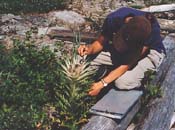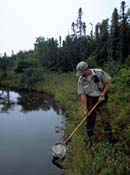Research
Mingan Archipelago National Park Reserve
The national parks play a key role in Canada's natural environment. As educators and the guardians of knowledge, their part in maintaining the biodiversity in all of the protected areas is of particular importance.
Scientific knowledge is essential to ensuring the ecological integrity of Canada's national parks.

Mingan Thistle Study
© Parks Canada / N. Dénommée, 2000
Flora Management Program
For over a century, the flora of the Mingan Archipelago has attracted the attention of the scientific community. Given its rather small surface area, the archipelago's rich and diversified plant life is quite remarkable, counting over 450 species of plants, 190 species of lichens and 300 species of moss. In addition to plants that are unique to the Gulf of St. Lawrence, some species in the archipelago normally only grow further north, further south or as far away as the Rocky Mountains. Limestone, wind, cold and the maritime climate all help provide each plant with the nutrients it needs to thrive.
In recognition of the importance of the archipelago's flora, we have identified 103 species of interest, deemed as such mostly because of their scarcity in the National Park Reserve or in the province of Quebec.
Some of the projects implemented to better know and protect these plants are:
- a management plan for plants of interest
- monitoring programs on plants of interest aimed at detecting changes in their populations
- a specific monitoring and re-establishment program for Mingan Thistle ( Cirsium scariosum ) colonies
- a specific monitoring program for Sparrow's-egg Lady's-slipper ( Cypripedium passerinum ) colonies
- the description and cartography of terrestrial ecosystems
- an inventory of plants introduced to the park
- hemlock looper detection
Fauna Management Program

Herpetofauna Inventory
© Parks Canada / B. Roberge / W 01 56, 1997
For generations, the diversity and abundance of the Mingan Islands' fauna has attracted the attention of the local and scientific communities. Despite its relatively small size, the park harbours over 10 species of reptiles and amphibians, 200 bird species and 20 species of land mammals, and can count nearly 15 species of marine mammals in the surrounding waters.
Despite their geographic isolation from the mainland and - due to their limited surface area - restrained capacity for support, the islands have become home to a diversity of terrestrial fauna. Herbivores such as the moose, the hare and the beaver have all found food and shelter on the islands. Certain carnivorous mammals such as the fox, the marten or the ermine live on the largest islands year-round.
Different species of woodland birds and even such threatened species as the Bald Eagle have also been observed here. The park's seabird population, which counts some 35,000 nesting couples, is particularly abundant. Some of the largest concentrations of eider ducks and terns in the Gulf of St. Lawrence are found in the park. Elsewhere, in the park's coastal zones, large seal colonies can be seen.
To better know, manage and protect this remarkable wildlife diversity, Parks Canada has been conducting a fauna management program for nearly 20 years. Among the management measures initiated over this period are sensitization to the issues, education, signposting, environmental assessments, and collaboration with local communities and resource managers. In addition to these measures, various scientific studies - notably population studies and the coordination of research findings with various searchers - have been carried out by Parks Canada.
- Date modified :